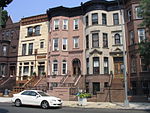13th Regiment Armory

The 13th Regiment Armory is a historic armory designed by architects Rudolph L. Daus and Fay Kellogg and built in 1892–1894. It is located at 357 Marcus Garvey Boulevard (also known as Sumner Avenue) between Putnam and Jefferson Avenues in Bedford-Stuyvesant, Brooklyn, New York City. Daus had previously designed the Lincoln Club on Putnam Avenue in 1889.The armory building is currently used as the Pamoja House (also known as Sumner House Shelter Care Center for Men), a homeless shelter for men managed by Black Veterans for Social Justice, Inc. and supervised by New York City Department of Homeless Services. The Pamoja House is named for the Swahili word for "together".The armory's design is expansive, yet austere. According to Francis Morrone, "Something, perhaps the busy-ness or a greater stridency in the machicolations, makes this armory seem more forbidding than the 23rd Regiment's which is actually rather jolly."
Excerpt from the Wikipedia article 13th Regiment Armory (License: CC BY-SA 3.0, Authors, Images).13th Regiment Armory
Marcus Garvey Boulevard, New York Brooklyn
Geographical coordinates (GPS) Address External links Nearby Places Show on map
Geographical coordinates (GPS)
| Latitude | Longitude |
|---|---|
| N 40.685 ° | E -73.9375 ° |
Address
Marcus Garvey Boulevard 357
11221 New York, Brooklyn
New York, United States
Open on Google Maps





